Where is the growth coming from? And where does it go to?
Yesterday I looked at the figures for the steem blockchain, comparing the first two weeks of December with the corresponding weeks in November. The story was very much one of growth: growth in user numbers, growth in post numbers, growth in post payouts, growth in the use of the alternative apps that have grown up around the blockchain.
But where is this growth coming from?
Well, everyone will have noticed that the Steem price exploded at the start of December. So everyone became a busy bee, the blockchain became a hive of activity, users join, post numbers go up, and everyone makes honey. It all sounds very rosy. But is this the real story? Or is there more to tell; the devil hidden in the detail as always?
I investigated.
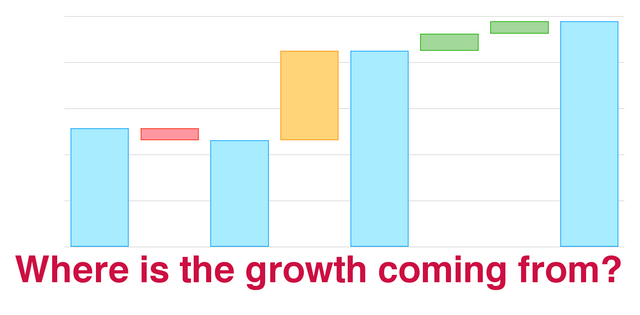
Let’s start with a reminder of the three month view (starting on September 1 and finishing at the end of our analysis period on 15 December). These figures are for the steemit.com platform only (which now represents around 70%-80% of the blockchain access, depending on which metric you use).
As always:
* The light blue line is the number of articles per day and the dark blue line is number of distinct authors. These are plotted against the left hand axis.
* The silver columns are author rewards and the gold columns are curator rewards. These are plotted against the right hand axis.
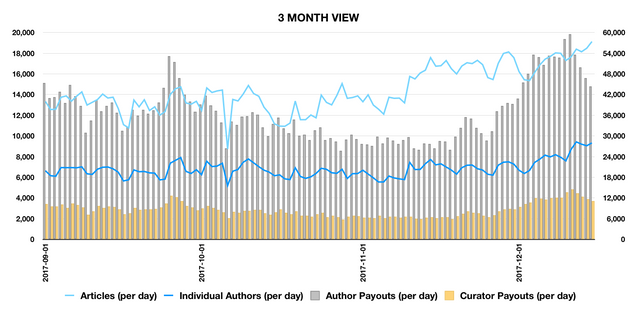
The chart seems to support the story. Rewards shoot up at the start of December, individual author numbers per day start to trend upwards, and numbers of posts increase their rate of growth.
Waterfalls
So let’s look at the detail. I’ve designed a waterfall that breaks down the growth in numbers.
The left hand blue column shows the total numbers for the first two weeks of November: the total number of individual users, the total number of posts (not comments) and the total amount of rewards generated by posting on the steemit.com platform.
The right hand column shows the same numbers but for the first two weeks of December.
The waterfall takes us from the November to December figures, with various pit-stops along the way. The blue columns are balances, the red, amber, and green floats are movements to get to those balances.
It’s useful to consider the picture as a whole, so I’ll post the charts first and then I’ll explain the movements and what they mean.
First up, individual author numbers:
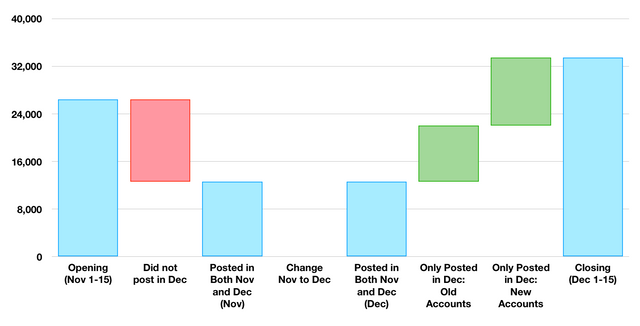
Next up, numbers of posts:
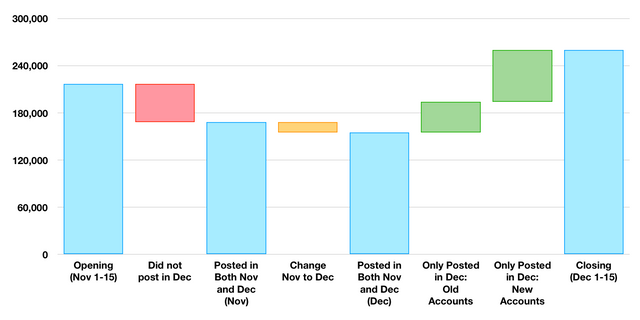
And finally we have rewards (total author and curator rewards):
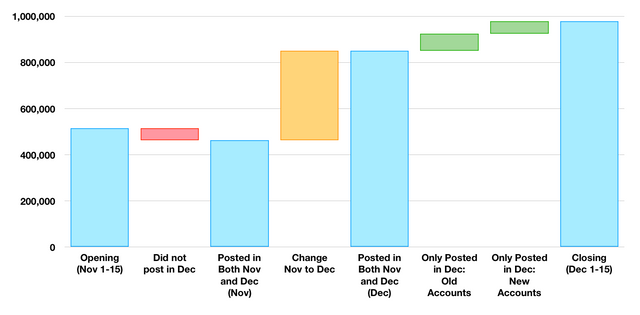
The red floats represent users that posted in the first two weeks of November, but not in the first two weeks of December. These users have stopped posting (or potentially moved to another platform to post, although no other platform has received such an increase in posters). There were a lot of them: nearly fourteen thousand out of the total twenty-six thousand, so over half (52%) of all individual users.
These 52% of users produced 23% of posts in the first half of November and gained 10% of rewards. Many users, a good number of posts, a small share of rewards.
The middle two blue columns represent the hard-core of users. These twelve thousand users posted on steemit.com in both the first half of November and the first half of December. They represented just under half of posters in early November, generated around three-quarters of posts, and took home 90% of rewards.
The amber floats show that these users (of which there were obviously the same number in November and December) actually produced slightly fewer posts in early December on steemit than in November (this time it’s quite plausible that they have spread their attention to other platforms). But most interestingly, the increase in rewards generated from posts on steemit.com, which was driven by the rising Steem price, was almost entirely to their benefit, and their benefit alone.
The green floats represent users that posted in the first half of December but not the first half of November. I have separated them between returning users (with accounts created before mid November) and new users (with accounts created after mid November).
As for the leaving users (in red) there are a lot of them, they post a fair amount, and they get few rewards.
Conclusions
So in conclusion, where does the growth come from, and where does it go to?
The growth in user numbers comes from new users and returning users outweighing users who stop posting. This is obvious. However what is not obvious is just how significant the movements were, even over a period in which the outlook for steem was extremely positive.
Between the first half of November and December we saw a 52% decrease from leaving users counterbalanced by a 36% return of users and 43% new users (all percentages measured against the November figures) for a 27% increase overall. While this increase in users is significant, it also represents a huge amount of churn and not at all the picture that might be expected from the steadily rising dark blue line in the first chart of this post.
The growth in post numbers is a similar picture. but on a smaller scale. A 20% overall increase in posts hides a 23% decrease from leavers and a 6% decrease in posts from the hard-core consistent posters, counterbalanced by an 18% increase from returning users and a 30% increase from new users.
The growth in rewards is a significant contrast. The 90% increase in rewards is generated by the rise in Steem price. Of this 90% increase in rewards, 75% (i.e 75% out of 90%) went to the consistent users in the centre with leavers and joiners representing only peripheral additions and deductions to the figures.
Perhaps these figures are to be expected. The distribution of power and rewards on the steem blockchain is such that a central core of committed users will obtain the vast majority of rewards. When the Steem price rises, existing users do not actually have to increase their output in any significant way in order to maintain their share of a rapidly increasing reward pool.
The majority of new users who arrive (or those who return) will remain on the periphery, unable to break into the system of rewards. They may not actually be benefitting from the rise in steem price in a significant way. Next month they may well be shown in red. I believe this is a risk. A continuing significant churn of users is detrimental to the reputation, growth and future success of the platform.
Clearly not every user who joins can immediately be showered in riches. Investment in Steem Power is the only fast way in. From being here for more than six months I know that there are opportunities for people who put in the effort and commit to the platform. But they need to get past that dry spell at the start. With a rising steem price, isn't now the moment to spend a little more of the reward pool seeking to encourage and retain new users? After all, it's for the benefit of us all.
Questions
Tomorrow I will complete my review of the mid month results with a look at the drivers of growth in some of the other steem blockchain applications.
In the meantime, if you have any questions or spot any errors please do not hesitate to leave a comment.
Methodology and Tools for Analysis
Tools
Raw data was obtained through sql queries of steemsql using Valentina Studio.
Data was analysed in LibreOffice and illustrated in Numbers (spreadsheet tools).
Data was obtained for various timescales, including a particular focus on Dec 1 - Dec 15 and the comparable period Nov 1 - Nov 15.
SQL query
I used the following SQL query. It took about 90 seconds to run, a little longer to write!
SELECT
Comments.author,
IIF(isjson(comments.json_metadata) = 1, IIF(CHARINDEX('/', json_value(comments.json_metadata, '$.app')) > 0, SUBSTRING(json_value(comments.json_metadata, '$.app'), 1, CHARINDEX('/', json_value(comments.json_metadata, '$.app'))-1),'other'), null) as [SummarisedApp],
Count(case when month(Comments.created) = 11 then Comments.author else null end) AS [PostsNov],
Count(case when month(Comments.created) = 12 then Comments.author else null end) AS [PostsDec],
Count(Comments.author) AS [Posts],
IIF(Count(case when month(Comments.created) = 11 then Comments.author else null end)>0,1,0) as [DistinctCommentAuthorNov],
IIF(Count(case when month(Comments.created) = 12 then Comments.author else null end)>0,1,0) as [DistinctCommentAuthorDec],
Count(distinct Comments.author) AS [DistinctCommentAuthor],
sum(case when month(Comments.created) = 11 then CONVERT(REAL,Comments.pending_payout_value) else null end) AS [PendingPayoutValueNov],
sum(case when month(Comments.created) = 12 then CONVERT(REAL,Comments.pending_payout_value) else null end) AS [PendingPayoutValueDec],
sum(CONVERT(REAL,Comments.pending_payout_value)) AS [PendingPayoutValue],
sum(case when month(Comments.created) = 11 then CONVERT(REAL,Comments.curator_payout_value) else null end) AS [CuratorPayoutValueNov],
sum(case when month(Comments.created) = 12 then CONVERT(REAL,Comments.curator_payout_value) else null end) AS [CuratorPayoutValueDec],
sum(CONVERT(REAL,Comments.curator_payout_value)) AS [CuratorPayoutValue],
sum(case when month(Comments.created) = 11 then CONVERT(REAL,Comments.total_payout_value) else null end) AS [TotalPayoutValueNov],
sum(case when month(Comments.created) = 12 then CONVERT(REAL,Comments.total_payout_value) else null end) AS [TotalPayoutValueDec],
sum(CONVERT(REAL,Comments.total_payout_value)) AS [TotalPayoutValue],
Accounts.name,
IIF(Count(case when Accounts.created < '2017-11-16' then Accounts.name else null end)>0,1,0) as [AccountBefore16Nov],
IIF(Count(case when Accounts.created >= '2017-11-16' then Accounts.name else null end)>0,1,0) as [AccountAfter16Nov]
FROM
Comments (NOLOCK)
inner join Accounts
on Comments.author = Accounts.name
WHERE
(CONVERT(date, Comments.created) >= '2017-11-01' AND CONVERT(date, Comments.created) <= '2017-11-15' and depth = 0) or
(CONVERT(date, Comments.created) >= '2017-12-01' AND CONVERT(date, Comments.created) <= '2017-12-15' and depth = 0)
GROUP BY
Comments.author,
Accounts.name,
IIF(isjson(comments.json_metadata) = 1, IIF(CHARINDEX('/', json_value(comments.json_metadata, '$.app')) > 0, SUBSTRING(json_value(comments.json_metadata, '$.app'), 1, CHARINDEX('/', json_value(comments.json_metadata, '$.app'))-1),'other'), null)
That's all for today. Thanks for reading!
Posted on Utopian.io - Rewarding Open Source Contributors
Approved.
Thank you for this sharing this fabulous analysis with us ;)
You can contact us on Discord.
[utopian-moderator]
Swift work! I appreciate it!
Really good analysis, thanks.
It's been a while since I posted, but I've been commenting and upvoting more than ever.
As my SP grows, it feels more beneficial to focus on onboarding and supporting newcomers than writing my own posts.
The lease payments from my delegated SP bring in a lot more than I could hope to earn through blogging.
If you strip out those who have continued to comment do the numbers look much better?
Thanks Matt!
It's a really good question. I've run this just on posts, rather than comments, for consistency with other analyses that I do. It would be interesting to see what the picture looks like with commenters added - there may be better user retention there.
There could also be greater rewards going to new users, who tend to comment a lot before they really get going with posting.
I'll see what I can do with the figures now you've sparked my interest!
it's still the same, only the freaks and geeks can really penetrate, along with some persevering artists and at home mom types, etc.
I think the rise in Steem price (and the rise in SBD) is a great opportunity to change things up a little.
We're already seeing what can be done with utopian, and there are great initiatives like OCD and Curie, plus a number of whales / orcas delegating out their power for the good of the platform.
I'd just like to see more done. With a particular brief to make sure we retain creative newcomers, make sure we hold onto the growth in numbers when prices flatten / drop back, stem the churn. There are some obvious ways it can be done and funded without hardforks or work from devs and using existing structures.
def much to do still / yes!
brother say something about blockchain....😃
It is a cause of endless fascination!
Hey @miniature-tiger I am @utopian-io. I have just upvoted you!
Achievements
Community-Driven Witness!
I am the first and only Steem Community-Driven Witness. Participate on Discord. Lets GROW TOGETHER!
Up-vote this comment to grow my power and help Open Source contributions like this one. Want to chat? Join me on Discord https://discord.gg/Pc8HG9x